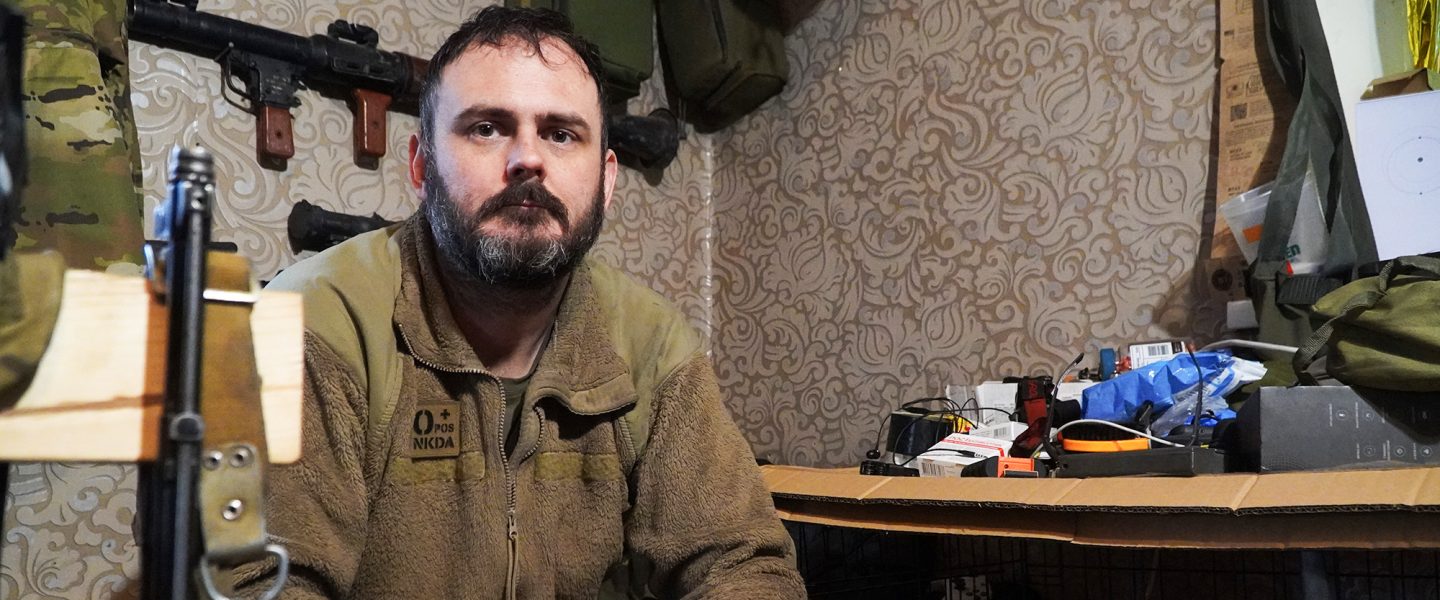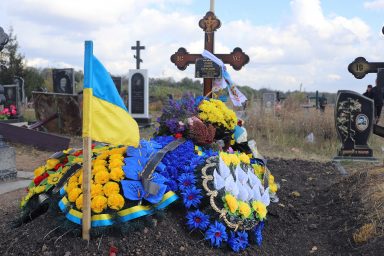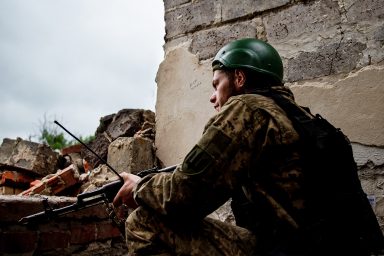Paul Smith has served in the Ukrainian army since the beginning of the Russian invasion. He has been close to losing his life and says this war is much worse than what he experienced in Afghanistan.
|
Listen To This Story
|
SOMEWHERE IN THE DONBAS, Ukraine — From his position on the Humvee, manning his 50-caliber machine gun, Paul Smith was firing steadily at the Russian positions when a ball of light appeared on the horizon. It was like a flashlight.
A strong light staring at him through the darkness.
Smith, who had his night vision on, felt that the light was frozen on the horizon.
“For me, it didn’t look like it was moving. It looked like somebody was shining a light on me. I decided to bend my head. I started shouting to warn others,” says Paul Smith about the incident this winter at the front line in Ukraine. “About seven seconds later, it hit.”
The shockwave pushed Smith down in the Humvee. A piece of shrapnel got stuck in his hand between his knuckles, and it felt like bones were breaking in his face due to the pressure of the Russian missile. He later found out that his left eye socket was fractured.
The medic on the team was also injured.

A selfie that Smith took after the attack this past winter. Photo credit: Courtesy of Paul Smith via Instagram
“Everybody was worried about me and wondering if I was going to come back [after recovery] because it was horrible,” explained Smith to WhoWhatWhy, as we spoke near the front line. “But I had to come back.”
“This war is more intense than the Gulf War, the Iraq War, the Afghan War, the war on terror. It is much different here in Ukraine,” he said. “I have survived three cruise missile strikes in Ukraine.”
Smith fully recovered after the injuries and returned to his unit.
“I remember I joked with the others under the first cruise missile attack. That it might be how the Iraqis felt when the US attacked,” Smith added. An American from San Diego, CA, the 37-year-old served in Afghanistan in the US Army.
A Desire to Help
WhoWhatWhy met Smith in a small village in eastern Ukraine with his team in the 59th brigade after he returned from the hospital. Smith is the leader of a small unit consisting of foreign soldiers with prior military experience, mainly from the US, Canada, and Britain. They are sent on some of the most dangerous missions. Their job includes attacking Russian fortified positions and participating in clearing trenches.
When in the US Army, Smith was stationed at Camp Humphreys in South Korea, and served in Afghanistan on one tour from 2011 to 2012 with the 10th Mountain Division. Smith visited Ukraine for the first time in 2008 and later decided to move there in 2012. He fought for Ukraine from 2015 to 2016, when the war broke out in eastern Ukraine after the Maidan revolution and the Russian annexation of Crimea.
Before the 2022 invasion, Smith planned to move his US-based machine company to Ukraine. However, he had to abandon those plans after the Russians invaded last February. Shortly after, Smith joined the newly established foreign legion consisting of nonnative men and women eager to defend Ukraine. Smith saw the Russian attack on Ukraine as an attack on his friends and his home.
Last March, Ukrainian Foreign Minister Dmytro Kuleba claimed that over 20,000 volunteers had joined the Ukrainian army. An official at the Ukrainian Embassy in Washington told The Washington Post last year that 4,000 were Americans.
“When I got here, I told the woman who was in charge of approval [for the foreign legion in Ukrainian Army] that I could help with this and that. She just rolled her eyes,” said Smith. “It was not until later that I found out that many people who came to Ukraine were lying about their prior experience.”
Smith had experience with the man-portable air-defense system Stinger and antitank weapon Javelin from the US Army but said that his knowledge wasn’t being used at first.
“There were solid individuals like myself who could do a lot of things and help Ukraine, but we kind of got screwed over by some selfish foreigners — Americans, Brits, and Canadians — with no military experience,” says Smith. “They just came here because they wanted to be able to come back home and share stories of how they fought Russia.”
“You had guys who went to the frontline and didn’t fight at all. They just started to hear the sound of artillery or air power and realized that it wasn’t for them,” added Smith. He later decided to switch from the foreign legion to the 59th Brigade, where he is now.
It’s unclear how many foreign fighters remain in Ukraine.
It Suddenly Said ‘Bang’

Smith first came to Ukraine in 2008 and fell in love with the country. The statue in the background is the Motherland Monument in Kyiv. Photo credit: Courtesy of Paul Smith via Instagram
Smith told WhoWhatWhy that he often receives messages on social media from people who want to come and fight alongside him. They see the videos and photos on his Instagram account and get inspired. Many are 19 or 20 years old.
“First, I ask them, do you have military experience? And if they say no, I just say, ‘Look, I can’t use you. And most of the Ukrainian units out here can’t use you,’” he said, adding that the war here is nothing like the movies or fiction.
It is almost a cliche in Hollywood movies that no man is left behind. But the reality is different, and Smith is reminded of that daily. A photo of a fallen Ukrainian soldier hangs near his bed in the village as a reminder of how brutal war can be.
Last year, a Ukrainian colleague was killed after Smith’s Humvee hit an antitank mine during an assault on the Russian positions at the front line. WhoWhatWhy saw the video of Smith sitting on the Humvee shooting at the Russians when everything turned black.
“I actually said to myself that if we didn’t hit a mine, if we didn’t hit an antitank mine on that trip because we were going to attack that village … then it would be a miracle,” recalled Smith.
Maksim, the Ukrainian soldier, had been sitting close to where the mine exploded. He wasn’t moving; the team assumed he was dead and decided to escape before the Russians started attacking them with artillery.
“We tried several times to reach him but were unable to … and had to leave him behind when the [other] Humvee arrived,” said Smith about the difficult decision to leave.
Back at camp, watching drone footage, Smith realized that they had made a mistake. On the live drone video, Smith could see Maksim on the field next to the destroyed Humvee moving his hand. They had left him there alive.
They went back to get Maksim, but they were too late. By the time they returned, Maksim had bled out.
“And, you know, there are so many things that I keep thinking about. What if we had done this or that?” said Smith.
“It’s a shitty situation to be in. We got hold of his body afterward. This war is just shit. You can’t do all those things… We would bring his body back ideally if we could, even if he were dead,” Smith said. He thinks that many people don’t understand just how brutal the fight in Ukraine is.
Smith was also wounded by the antitank mine explosion, which left him with micro shrapnel in both legs.
Need to Erase the Soviet Legacy

Smith serving in Afghanistan in 2011. This photo was taken at Forward Operating Base Jelawur in the Kandahar region. Photo credit: Courtesy of Paul Smith via Instagram
The war in Ukraine differs significantly from what Smith experienced in the war on terror. In Afghanistan, the US had better equipment than the Taliban and didn’t have to worry much about air attacks. In this war, the Russian army has more firepower than the Ukrainians, and the Russians attack with missiles and rockets deep into Ukrainian territory.
Guy McCardle, managing editor of Special Operations Forces Report (SOFREP), told Newsweek this year that Russia “is firing at least four times as many artillery shells as Ukraine.”
Many people see the Russian invasion of Ukraine as an artillery war similar to World War I, where soldiers fight from the trenches and rely on artillery bombardments.
“The Ukrainians are also fighting in a different way than we would in the US,” said Smith, adding that some Ukrainian units, especially at the beginning of the war, fought as the Soviet Union did. Among other things, this means that they attack enemy trenches head-on.
Smith says that parts of the Ukrainian military have changed to NATO tactics, but changes don’t happen overnight. Smith spends a lot of time teaching his brigade how to outflank the enemy.
“These problems were also why I started this little international team within the brigade,” said Smith. “Here, we can [because of our training in the West] perform special missions, which will ultimately help and be able to support the Ukrainian military as a whole.”
Waiting for Victory
Smith said his job in Ukraine is far from over and that he will continue fighting. He believes in a Ukrainian victory but knows that he might not survive to see it. Every time he leaves on a mission, there is a risk that he won’t return.
“I just focus on the tasks at hand, and when I finish a mission, I come back here and just decompress,” said Smith, “Maybe watch videos on Youtube or Netflix or play a mobile game. I just don’t think about how it was to be there.”

On a village wall near the frontline, people have left messages of thanks and good will for members of Smith’s brigade. Photo credit: Stefan Weichert / WhoWhatwhy
Smith doesn’t worry about developing post-traumatic stress disorder from what he has seen but is aware that many foreign and Ukrainian soldiers will face such problems in the future.
Previously, a video of a Russian soldier beheading a Ukrainian soldier was published on social media and received worldwide attention. It isn’t clear whether the video is authentic, but videos such as these are a reminder about the brutality of the war, Smith said.
“The total disregard for life in this war. What the Russians did to that poor boy,” said Smith about the video showing the beheading, “I tell my guys that the Russians are always a threat until they no longer are a threat. Either they completely surrender, or they are dead.”
After the war, Smith hopes to start a machine factory in Ukraine.
“I am very focused on the future, and I think that it helps me or isolates me from the horrors that I see here,” Smith said, though he realizes that this sets him apart from many soldiers in this war.
“I don’t have nightmares,” Smith added. “I don’t have negative effects from what I have seen, but I hope to help others after this. Help soldiers with PTSD or suicidal thoughts recover.”




